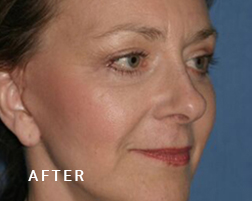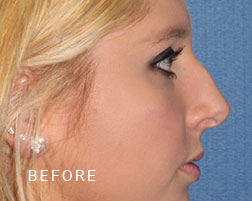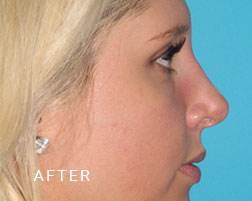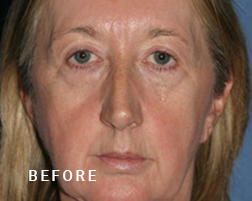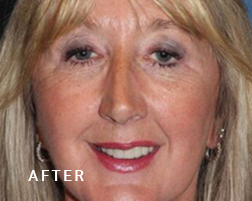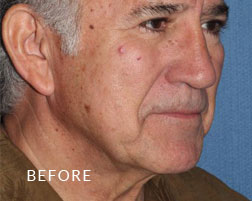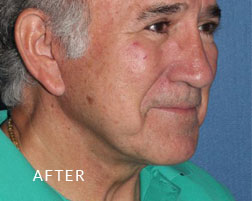Preservation Rhinoplasty
Offered at our convenient location in Scottsdale, Arizona
Preservation Rhinoplasty is an approach to nasal surgery that keeps the structural integrity of the nose intact while making the desired modifications. Other rhinoplasty methods involve removing sections of bone or cartilage, which can lead to complications. Preservation rhinoplasty “preserves” these important structural forms by using advanced knowledge of nasal anatomy and specialized techniques such as strategically placed sutures to alter the shape of the nose.
For such a small piece of our anatomy, the nose is an incredibly complex body part. Underneath the many layers of tissue sit symmetrical sections of cartilage, ligaments, a complex array of muscles, and essential networks of blood vessels and nerves. It also happens to be a body part that sits in the middle of our face, making a sophisticated surgical approach well-warranted, to put it lightly!
Rhinoplasties are considered one of the most challenging aesthetic surgeries to perform and have one of the highest rates of revision surgery. (1) However, surgical techniques for rhinoplasties have undergone continuous improvement, and preservation rhinoplasty is currently considered a “revolutionary” approach for achieving the very best results. (2)
Dr. Andrew Wolin is dedicated to offering his patients every advantage. He utilizes the very latest in technology and technique and regularly attends training and seminars to further perfect outcomes. If you’ve been considering rhinoplasty, you owe it to yourself to explore all the options available. Make an appointment for a personal consultation with Dr. Wolin to learn more about the intricacies of this procedure so that you can make an informed decision. You can reach his Scottsdale offices directly by calling (480) 945-8440, or by filling out this simple online form at your convenience.
Contents
About
Until fairly recently, doctors were still discovering new aspects of nasal anatomy. Preservation rhinoplasty is a direct result of this improved understanding of nasal anatomy and surgical techniques. Surgeons can access the structures of the nose more directly, reposition them with less trauma, and achieve more predictable, natural looking-outcomes. The high rate of complications that occur after a rhinoplasty are often a result of overagressive excision. As a result, surgical revisions are frequently performed, and require grafts of cartilage harvested from other parts of the patient’s body. This is often because two much of the internal structure of the nose was removed during the primary rhinoplasty. (1)(2) The objective of preservation rhinoplasty is to avoid this risk altogether.
Nasal Anatomy
Depending on the patient’s desires and nasal shape, several inner parts of the nose may be adjusted during a rhinoplasty.
- Nasal Bones: The very top of our nose is formed by two small symmetrical nasal bones that extend from between our eyes.
- Upper Lateral Cartilage: The nasal bones slightly overlap the two sections of upper lateral cartilage that form the upper right and left sides of the nose at the dorsum, or bridge of the nose.
- Alar Cartilage: Just beneath the upper lateral cartilage are the two sections of lower lateral, or alar, cartilage that connect and curve downwards to form the tip of the nose. This cartilage also extends outward, just above each of our nostrils.
- Septal cartilage: This long strip of cartilage bisects the length of the nose, dividing the right and left sides.
- Soft Tissue Envelope: This includes the skin, connective tissue, muscles, and blood vessels that encase the nose.
Another Way To Think About The Nose
If you’ve ever been camping, you’ll already understand some of the challenges accompanying rhinoplasty. The inner support structures and outer soft covering of tissue that compose the nose are similar to the parts of a tent! Getting the poles in place and firmly connected is important for holding the entire structure aloft. Softer components like the fabric that covers the inner framework and the elastic threading that holds the poles together are also necessary to give the tent its shape. Previous approaches to rhinoplasty involved trimming away bone and cartilage, which would be similar to cutting down the lengths of the poles that hold your tent together. But, removing too much of this will leave you with a droopy tent, or one that collapses altogether.
Today’s rhinoplasty surgeons also appreciate the importance of the nasal ligaments. These are similar to the elastic that runs inside the individual sections of pole, and that let you pitch and break down the framework of your tent. These ligaments keep the sections of cartilage that form your nose in place, as well as connect to other important parts of the nasal anatomy.
The fabric shell of a tent is similar to the tissues that form the soft tissue envelope of the nose. Surgeons previously gained access to the inner structure by working in more superficial layers of the exterior nasal tissues, which led to a thinning covering of skin and additional complications. That’s not the kind of tent (or nose) that’s going to endure the elements.
Preservation Rhinoplasty Avoids Complications
Removing areas of nasal cartilage also requires surgeons to reassemble the intricate connections between the sections of cartilage and bone. So, besides the risk of removing not enough, or too much of these pieces, many traditional rhinoplasty approaches also risk instability from insufficient reconstruction during surgery. These risks include:
Functional Disturbances
After a rhinoplasty, patients can experience breathing issues and the sensation of a blocked nose from narrowed airways or collapsed vaults. There is also the risk of nerve damage that can compromise sensation.
Aesthetic Deformities
There are many undesirable outcomes that can be caused by removing too much structural tissue, inadequately reconstructing the nose, or damaging the soft tissue envelope during surgery. These deformities include:
- Open roof: Dorsal hump reduction can lead to a widened center of the nose due to missing cartilage and bone.
- Saddle nose: A collapsed nasal bridge creates a disruption in the profile of the nose, and causes the tip of the nose angle out sharply from the area above.
- Inverted V: An excessive gap between the bottom of the nasal bones and the upper lateral cartilage becomes visible, creating a prominent v-shape at the dorsum.
- Pollybeak: The tip of the nose rotates downward.
- Alar collapse or an overly “pinched” nasal tip: Removing too much of the outer or inner alar cartilage causes the tip of the nose to become distorted. (3)
- Thinning skin, or shrunken nose: Trauma to the soft tissue envelope during surgery can lead to excessive scarring underneath the layers of tissue. As the nose heals, this can cause the skin to thin and contract, warping the appearance of the nose.
How Preservation Rhinoplasty Ensures Ideal Outcomes
The Soft Tissue Envelope
During a preservation rhinoplasty, the surgeon accesses the structures of the nose directly, rather than separating the layers of tissue that encase them. The entire soft tissue envelope is lifted from directly above the cartilage and bone. A better understanding of the soft tissue that encases bone and areas of cartilage allows them to avoid damaging other crucial areas of the nose. Importantly, this includes the network of nasal ligaments. These small but mighty strips of connective tissue keep the sections of cartilage that form the shape of our nose in place. These can then be manipulated to shift the positioning of the cartilage and adjust the shape of the nose.
Preserving the Nasal Dorsum
Many aesthetic rhinoplasty patients are looking to reduce a dorsal hump. Additional anatomical knowledge has revealed the overlap of the nasal bone and upper lateral cartilage. As a result, this bone can be gently rasped down, or carefully removed. This eliminates the risk of many common aesthetic complications that result from damage to the area, as well an easier recovery for the patient. New technology such as ultrasonic piezotome tools allow Dr. Wolin to more delicately sculpt nasal bones, with less trauma to the surrounding tissue.
Keeping the Alar Cartilages Intact
The alar cartilages form a curved “tripod” that supports the tip and lower sides of our nose. Rather removing sections of this structure, surgeons can place sutures that adjust the tension of its curvature to create the desired shape. (4)
Personal Consultation
If you’re interested in preservation rhinoplasty to solve your functional or aesthetic nasal concerns, the first step is a personal consultation with Dr. Wolin. After getting to know more about you and what you’d like to change about your nose he’ll review your medical history to ensure that you are a good candidate for surgery. All of Dr. Wolin’s patients undergo a comprehensive nasal analysis. They are also able to preview their results with specialized imaging software. Not all nasal concerns can be addressed with a preservation rhinoplasty, but Dr. Wolin will recommend the best approach for achieving optimal results. To learn more about the other services that Dr. Wolin offers and what sets his practice apart, take a look at his reviews.
If you’re interested in taking advantage of the many benefits of preservation rhinoplasty, schedule an appointment for a personal consultation. You deserve the very best results, and Dr. Wolin is ready to help. Call our offices today at (480) 945-8440 to get started.
How Much Does Preservation Rhinoplasty Cost in Scottsdale?
Like any facial plastic surgery, the approach and techniques are customized to the patients unique anatomy and desires. As a result, the cost varies slightly from patient to patient. You’ll recieve an accurate estimate following your personal consultation with Dr. Wolin.
References
- Bussi, M., Palonta, F., & Toma, S. (2013). Grafting in revision rhinoplasty. Acta Otorhinolaryngologica Italica, 33(3), 183–189. https://www.ncbi.nlm.nih.gov/pmc/articles/PMC3709529/
- Daniel, R.K. (2018). The Preservation Rhinoplasty: A New Rhinoplasty Revolution, Aesthetic Surgery Journal, 38(2). 228–229, https://doi.org/10.1093/asj/sjx258
- Rettinger, G. (2008). Risks and complications in rhinoplasty. GMS Current Topics in Otorhinolaryngology, Head and Neck Surgery, 2007(6). https://www.ncbi.nlm.nih.gov/pmc/articles/PMC3199839/
- Daniel, R. K., & Kosins, A. M. (2020). Current Trends in Preservation Rhinoplasty. Aesthetic Surgery Journal Open Forum, 2(1). https://doi.org/10.1093/asjof/ojaa003



